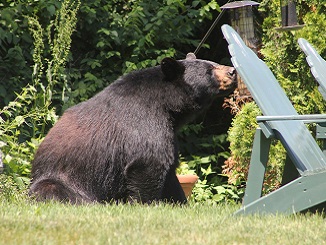Black bears are especially active this time of year, and for a couple primary reasons: food and breeding. Increased chances of an encounter makes bear education important for wildlife managers, citizens, and the bears themselves. This will help explain why they’re so active and how to share the land with these amazing wild animals.
Breeding Season
The “rut” is on!
Most people are very aware that the whitetail deer breeding season (a.k.a. – the rut) occurs each autumn. But, did you know that right now the breeding season for black bears is in full swing? Males (boars) are actively in search of receptive females (sows), and will travel many miles to find one. The search for a mate also results in bears spending more time in open spaces during daylight hours – something that’s typically not common during other times of the year.
Searching for Food
In addition to their travels in search of a mate, bear sightings in residential areas may also increase as bears search for food. Not to worry, they aren’t looking for humans! Black bears are attracted to backyards with bird feeders, pet food or garbage cans that are not secured.
A few tips to live or hike in areas with black bears:
- Remove food attractants: Take down bird feeders, secure garbage cans, and keep pet food indoors.
- Keep your distance: They are wild animals and it’s imperative to respect their space. This is both for safety and to keep them wild.
- Let animal move on: Observe from afar and allow the bear to continue on it’s way, uninterrupted.
- Talk to your neighbors: Even if you don’t offer food, your neighbor might unintentionally be doing so, which will still attract bears to your area. Have a conversation to make sure you and your neighbors all work together to minimize bear visits and potential negative encounters.
- Be aware and make noise: Black bear encounters can make a person scared or hesitant to go outside. You can have a buddy outside with you while gardening and make noise to discourage the bears from visiting.
- Things to avoid: Two things that can trigger a negative encounter with bears are (1) getting too close a sow’s cubs and (2) unintentionally surprising a bear or creating a situation where it feels cornered.
Remember to share the land with these wild creatures!
— Gregory A. Knutsen, Refuge Manager at Rydell National Wildlife Refuge
